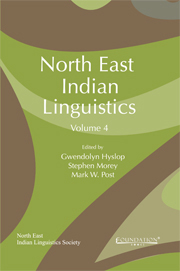Book contents
- Frontmatter
- Contents
- About the Contributors
- Foreword
- A Note from the Editors
- History, Contact and Evolution
- Bodo-Garo Grammar
- Orthography, Poetics and Text
- 7 Tshangla Orthography
- 8 Poetic Forms in Nocte, Singpho, Tai and Tangsa
- 9 A Multi-purpose Project for the Preservation of War Oral Literature
- New Descriptions
- Classifiers
- Eastern Indo-Aryan Grammar
- Austroasiatic
9 - A Multi-purpose Project for the Preservation of War Oral Literature
from Orthography, Poetics and Text
Published online by Cambridge University Press: 05 May 2013
- Frontmatter
- Contents
- About the Contributors
- Foreword
- A Note from the Editors
- History, Contact and Evolution
- Bodo-Garo Grammar
- Orthography, Poetics and Text
- 7 Tshangla Orthography
- 8 Poetic Forms in Nocte, Singpho, Tai and Tangsa
- 9 A Multi-purpose Project for the Preservation of War Oral Literature
- New Descriptions
- Classifiers
- Eastern Indo-Aryan Grammar
- Austroasiatic
Summary
Overview of the Mon-Khmer (MK) languages of India (Meghalaya, Assam) and Bangladesh
The MK group of languages spoken in NE India, especially in Meghalaya since the formation of this State in 1972, is currently known as Khasi or Khasian. These two terms correspond to different facts and to an unsettled question. Standard Khasi has become the lingua franca and the written language of the MK eastern area of Meghalaya since British colonisation. This situation reflects the political and socio-economic leadership of the Khasi group over other MK groups in Meghalaya and also the isolated cultural situation of the MK group inside NE India. As a state of India, Meghalaya has two parliamentary constituencies: a Garo one and a Khasi one. Any War, Pnar or Lyngngam person would say he is Khasi as some kind of “national” identity, different from any other neighbouring Tibeto- Burman (TB) or Indo-Aryan (IA) identity. On the other hand, “Khasian” is not an empirically defined term from the viewpoint of MK linguistic classification. The chapter in Grierson (1904) on “Khassi” and its Synteng (that is Sutnga Pnar), Lyngngam and War “dialects” provides basic lexical lists of 200 items and two translated Bible texts in those so-called dialects. This material shows important lexical dissimilarities and deep morphosyntactical differences. Those languages are labeled “corrupted dialects” of Khasi by Roberts (1891), who provided the data. Those groups and what remains of the former dialects of Khasi: Mylliem and Khyrim (or Khynriam), have never been thoroughly surveyed.
- Type
- Chapter
- Information
- North East Indian Linguistics , pp. 166 - 194Publisher: Foundation BooksPrint publication year: 2012
- 1
- Cited by



